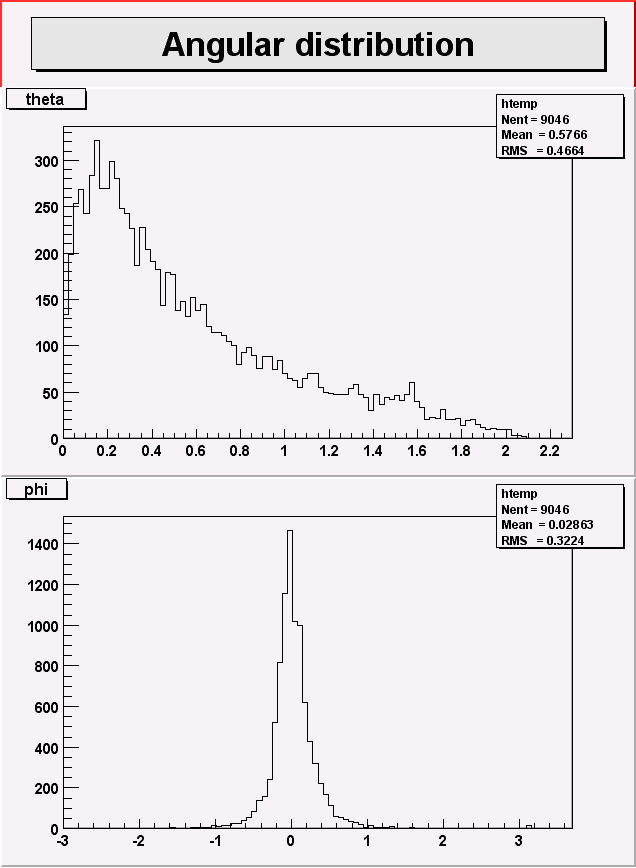
ER Tracking & ER Spectrometer Alignment Study
1. Run Selection:
From 08/03/99 Run 1161. New TrigBit setting applied. Heinz recommended to look at runs
1167 (560ns) 100k events
1168 (560ns) 330k events
1172 (760ns) 70k events
1175 (660ns) 30k events
I started with the run 1168, the biggest run. The run are saved into
11 different files (s000 to s010).
The raw data files are now on
/disk20000/phobos/scratch/engrun/PhoRaw001168s0**.root
2. Raw data processing (Processing Hit)
Raw data were processed with the following setup:
detector: EngRun detector, $PHATHOME/init/Detector_eq.root with version
31.500,
SensorDB: provided by ONLINE group
Si gain : /disk20000/phobos/disk0/eng_run/gain/CalSiV00r001151.root
Trigger bits, 10, 11, 19 are used for the preliminary event selection.
Processed data, having "HitsCalibrated" data container, were copied into my directory as the PhDST format (nothing but a TFile).
/phobos/u/icpark/align/DSTh/dsth001168s0**.root
3. Event Selection, DST data processing (Process Track)
Tracks are reconstructed as following (especially disigned for the alignment study):
1) starting with a hit of layer B,
2) making all the straightline combinations with hits on layer D (no fitting is done)
% both layers are the same type. (1mm x 1mm) size.
% layer B is considered as the reference frame.
% layer D is assumed that it is perfectly aligned.
3) for the all combinations (no fit), we extrapolate the straightline to the layer F and check whether there exist hits inside XxY retangular box (X and Y are in the local sensor space, not real x,y,z coordinates). Since the pad size of the layer F is 0.4mm x 6mm, I use 5 millimeter for X and a centimeter for Y. I will use bigger values to see big aligment effect first, and then decrease them if layers are well aligned.....
4) Now fit the straight line (using TPhStraightTrack Class) and get Chi2, Prob
5) Select good tracks by TPhTrackSelector
The tracks are saved into a DataObjectContainer, named "ERTracks", and
Only events with tracks are copied into a different DST file.
These DST files are kept in my
/phobos/u/icpark/align/DSTt/dstt001168s0**.root
4. Data Analysis
For a straight line, having exactly 3 hits in the ER setup, we can calculate the impact parameters, d0, and z0. The definitions of the two variables are important:
d0 = distance to the minimum approach to the beam axis in XY plane (has
sign of vec(r) x vec(p)).
z0 = z position when the track approach to the beam axis minimally.

As you see RMS of d0 is about 3cm. That means tracks come from beam!
I.e. inside beam pipe!
z0 distribution is asymmetric but is reasonable because beam comes
from -z direction and our spectrometer setup is designed for +eta region.
Another interesting plot is the one that show the track's direction.
As one can expected, theta angle (angle between track and beam axis) should
be small for beam-gas interaction. And Phi angle (tan^-1(Py/Px)) should
be small and near to zero since SpectP is on the positive x axis.

Clearly d0 and phi are correlated, as z0 and theta

I can make residual plot on X and Y. I do not use the straightline fit in this case because then my relative alignment information between D and F is smeared by the pad size & layer B...(correlated!)
% we will see well the relative alignment along local X coordinate between layer D and F, but Y due to pad size.....

At this moment, statistic is not yet enough to say something for mis-alignment.....
Keep an eye on this web! Bye,bye